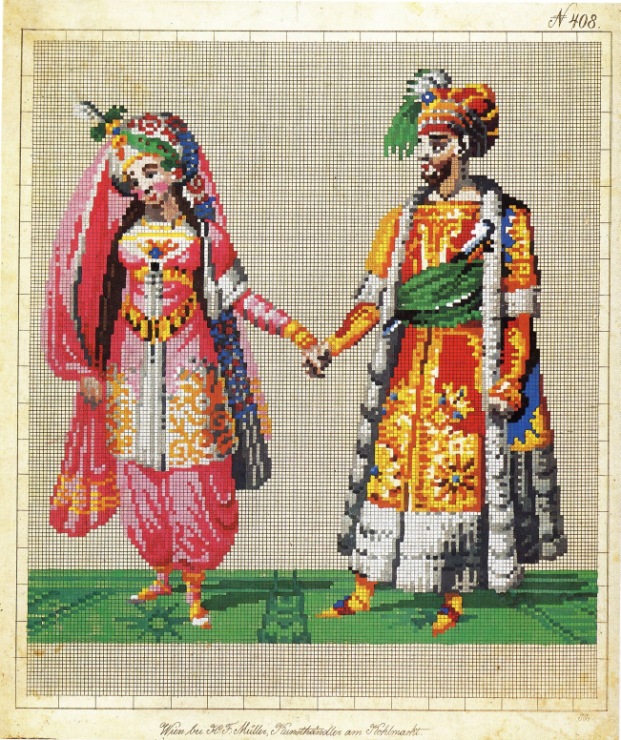My brain just did this
It all started out innocently enough. My mind has been itching for a new project ever since I sutlered at Jackson. I've made a point of improving/adding to my online store as well, though that process is quite exhausting. Pinterest...I was mentally munching through pinterest when I came across this handsome guy:
A dog? Oh my goodness! I was instantly intrigued by the possibility of stitching a pet, even though I had no experience stitching whatsoever (since when do I let anything stop me?). What I found was Berlin Woolwork, and the entirety of cross stitch charts.
Embroidery is not a modern invention. For thousands of years humans had been stitching away, with evidence of a form of cross stitch found in ancient Egypt. Designs were painted or drawn right onto the canvas, allowing for more artistic freedom. Technology changed everything in the 18th century, and suddenly hundreds of blocked paper patterns could be printed in a day. The fashion began in Berlin, Germany, and swept Europe by storm. By the early 19th century, thousands of patterns were sold a year, with ladies carefully following those little blocks.
As I dove headfirst into my research, I was enthralled by the many types of designs. Perhaps the most commonly known is the floral design, one that is almost synonymous with the 19th century. Brilliantly colored flowers graced the pages of so many magazines, from so many countries! I've seen this pattern on so many items from the Victorian era, it's almost a staple!
1861
Next I found a variety of charts relating to landscapes. The far off castles, the gentle rolling hills; I can imagine the 19th century woman finding peace in her stitches. Most seemed to depict distant, idealistic scenes. Traveling was a much more arduous task in the 19th century, so these were places that a lady could encounter in her daily walk. What pretty exercise that would be!
Utterly obsessed, I continued. I noted a large amount of charts that related to animals. Birds, rabbits, dogs, cats, horses, foxes, and every little critter in between. While animals were often symbolic, I suspect that the 19th century population may have loved their pets as sincerely as we do today. If I find time to replicate a pattern, it will certainly depict a dog!
1804-1899
1847
1857
Date Unknown
1847
Not all charts were playful. Many held religious significance, with a few allegories thrown in the mix. I'm sure the 19th century parent approved of such stitchery, as the moral lesson accompanied the needle. I've also included mourning in this category, as such depictions were common in samplers too.
For every stitched moral lesson, I found a dangerous adventure. Scenes depicted exotic animals, people, and places. These portray an exciting life outside of the normal, mundane activities. I can imagine a woman sitting at her needlework, daydreaming of Arabian nights. Perhaps a knight in shining armor as well?
As I searched, I found so many little projects that followed the cross stitch technique. Glasses cases, wall-pockets, cushions, foot rests, bell pulls: all were finely ornamented with such detail. It never ceases to amaze me how much time these ladies spent on what we would consider an innocuous object. Everything was just so darn...pretty...
18561857
Date Unknown
For all of my research I found many setbacks. Most patterns online did not include a date. This is an incredibly frustrating situation. Several women on pinterest put up so many patterns! A simple year/publisher would clear up the confusion, and allow for more authentic reproductions. I will be contacting several of those women to see if I can add dates to the ones I have in this post.
Needless to say, I am excited about my next project. I don't often see woolwork at reenactments, and I hope this posts generates interest. How awesome would that be to see a few of these items at every event? I feel another project coming on...
~Kristen
Sources
Textile Museum Of Canada





































A friend of mine did her master's thesis on 19th century berlin work. If you can access JSTOR, it's available to read there: http://www.jstor.org/discover/10.1086/663734?uid=3739936&uid=2&uid=4&uid=3739256&sid=21104173912171
ReplyDelete